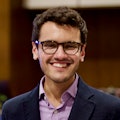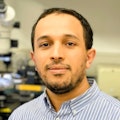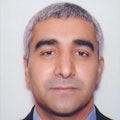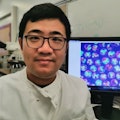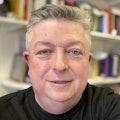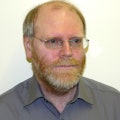Our researchers in the Centre for High Frequency Engineering are carrying out cutting edge, industrially relevant research in the areas of communications, sensors and materials.
Our research covers the specific areas of the fundamental science and applications of electronic materials, wireless communications systems, sensor technologies, embedded systems, signal conversion/processing and microfluidics. This research has a significant impact in areas as diverse as security, advanced materials, energy and health.
Aims
We aim to conduct world-leading, interdisciplinary research using high-end electronics technology to solve tomorrow’s engineering challenges.
Research
Microwave Characterisation Laboratory
The Microwave Characterisation Laboratory, managed by the Centre for High Frequency Engineering (CHFE) was founded in 1996 and provides researchers with access to state-of-the-art characterisation equipment operating from a few MHz to hundreds of GHz. Advanced microwave and mm-wave characterisation facilities are enabling the development, fabrication and analysis of the very latest high-frequency electronic devices, circuits and systems needed for the next generation of communication systems, satellites, radars and medical imaging devices.
Technical features
At the core of this facility, there are four microwave harmonic load-pull systems for the large-signal characterisation of high frequency transistors, providing the ability to measure the real-time, intrinsic current and voltage waveforms that exist within active devices.
The information produced enables a technique pioneered by the CHFE called “Waveform Engineering”, providing key design information to support the design, development and optimisation of the latest microwave and mm-wave compound semiconductor device technologies as well as the circuits and applications that use them, such as energy efficient power amplifiers for 5G.
The most advanced of our systems is a 110-GHz source/load pull capability acquired through an EPSRC Strategic Equipment grant, and that can characterise and control ‘on-wafer’ devices. This unique system can measure device-level waveforms at mm-wave frequencies, supporting the important development of 5G and future 6G technologies.
Supporting the South Wales Compound Semiconductor Cluster activities, the Laboratory also hosts a 130-GHz small-signal electro-optical characterisation capability for on-wafer devices.
Practical applications
The laboratory has several Power Amplifier testing capabilities, able to characterise the latest generation of multiple-input architectures such as Digital, Doherty, envelope tracking (ET) and load modulated balanced (LMBA) power amplifiers realised using both conventional PCB and monolithic microwave integrated circuit (MMIC) fabrication techniques. Using these capabilities, the CHFE and its research partners have been able to develop high-performance energy-efficient wireless systems, and test them using realistic signals, assessing their ability to perform in the real-world scenarios.
Microwave Science Laboratory
The application of advanced radio frequency (RF), microwave and mm-wave engineering techniques presents solutions to many research challenges across the whole of the physical and life science application space.
Our work within the Microwave Science Laboratory explores the basic interactions of high frequency electric and magnetic fields with materials, enabling for example novel low-power sensors that can detect minute changes in blood glucose, as well as high-power applicators to drive physical processes needed for the liberation of DNA from within bacterial spore.
These activities are strongly linked with those in the Microwave Characterisation Laboratory and the Applied Microfluidics Laboratory.
Technical features
The Microwave Science Laboratory is managed by the Centre for High Frequency Engineering (CHFE) and provides researchers from within and outside Cardiff University access to state-of-the-art equipment for characterising materials and systems, and modelling electromagnetic field interactions, from sub-GHz frequencies to more than 20GHz, with the potential to extend to 110GHz using equipment from the co-located Microwave Characterisation Laboratory.
Our standard high-frequency equipment includes three benchtop network analysers, five portable network analysers (for taking into the field, or to external laboratories), impedance analysers and spectrum analysers. Our simulation suites include five full COMSOL Multiphysics licences for EM field interactions and EM field modelling generally, and Pathwave Advanced Design System (ADS) for circuit-based simulations and EM co-simulations.
Practical applications
Key to our activities is our ability to design bespoke systems around the scientific problem that needs to be investigated. This includes in-house design, build and test of high frequency sensors and applicators for measuring and enabling ‘front-end’ EM field interactions, together with the electronics and control software to drive the front-end components.
We specialise in developing embryonic interdisciplinary research and have deployed remote, mobile microwave capabilities into off-site laboratories, where there was no prior expertise in this instrumentation. Examples include:
- Development and installation of bespoke microwave cavities for electron paramagnetic resonance (EPR) spectroscopy, currently in action in the laboratories of the EPR group in Cardiff’s School of Chemistry (led by Prof Damien Murphy).
- Development and installation of bespoke microwave applicators and drive electronics for the rapid release of DNA from various pathogens to aid their rapid detection, currently in action in the laboratories of Prof Les Baillie, in Cardiff’s School of Pharmacy.
- Bespoke microwave cavities to study uptake of polar species by a combination of microwave interactions and neutron diffraction, e.g. applied to energy materials in the context of the solid state storage of ammonia, installed in the POLARIS neutron beam at the Rutherford Appleton Laboratories, in collaboration with Prof Martin Jones (Energy Materials Coordinator, STFC).
- Use of RF and MW techniques in additive manufacturing at Renishaw’s main site in New Mills, Gloucestershire (with Prof Geoff McFarland, Director of Group Technology).
- Development of RF non-invasive blood glucose sensors, which is undergoing current commercialisation with the GlucoRX group of companies (CEO Nilesh Nathwani).
We welcome new collaborations with academia and industry, driven by curiosity and the need to solve the current grand challenges, in which novel electromagnetics technologies will have a major role.
Applied Microfluidics Laboratory
The Applied Microfluidics Laboratory was founded in 1995, with substantial funding from the UK Royal Academy of Engineering, Royal Society and Wolfson Foundation, and specific grant funding through EPSRC, MRC, European Commission, Bill & Melinda Gates Foundation and Welsh Government. The laboratory has worked with over 30 companies on diverse industrial projects including KTPs and 4 EU consortia. The laboratory has made 18 IP disclosures, filed several PCT / US patents and founded microfluidics companies such as Q-Chip Ltd. (f. 2003, injectable microencapsulated pharmaceuticals; merged Midatech; AIM floated 2014, Nasdaq listed 2015). It is directed by Professor David Barrow and Co-director Dr. Jin Li.
Technical features
The laboratory has been adept at constructing custom design instrumentation set-ups for specific scientific applications, ranging from hybrid microdevice integration to bespoke micro-instruments for cellular encapsulation, fusion target fabrication and the manufacture of artificial cells.
The laboratory also accommodates the following facilities:
- COMSOL MultiPhysics Modelling Suite and high-end computational hardware for (i) Acoustics (ii) Chemical Reaction Engineering (iii) Heat Transfer (iv) Microfluidics (v) Molecular Flow (vi) Particle Tracing (vii) Ray Optics (viii) Structural Mechanics, and (ix) Wave Optics.
- 2m x 1.5 air levitated table for vibration-free microfluidic analysis
- Fluid delivery through (i) several positive displacement precision syringe pump systems, and PC controlled multiport Elvsys pressure-driven delivery systems.
- Thermofisher HPLC-quadrapoleMS analytical tools
- EG&G PARC 2703 Electrochemical Analysis Suite
- 400fps imaging systems for fluid flow monitoring
- Ultimaker 2, 3, S5 (air drier+extraction) Fused Filament Printers
- 2 x all chemical extraction hoods
- Several substrate drying and heated vacuum ovens
- LPKF PROTOMAT S63 Milling System
- RF Au sputtering system
- Jenway 2405 Spectrophotometer
- Bruker Optical Interferometer for surface micro-and nano-analysis
- Range of Nikon Optical Measurement Microscopes
- Cell culture facility with 5% CO2
Practical applications
The laboratory has researched a diversity of phenomena and devices, including chemical sensors, porous silicon, micro-acoustics, hybrid electro-optical micro-integration, micro-moulding, emulsion and digital microfluidics, chemicals separations, polymer plasma etching, CFD, microwave sensors, cellular encapsulation including stem cells, micro-reaction engineering, transdermal microneedles, laser micromachining, marine microanalysis systems, fusion energy targets, zero gravity experimentation and protocells.
The laboratory now researches 3D multi-material additive manufacturing to create multifunctional microfluidic motherboards, that can be prototyped and revised in fast succession. Its fundamental research is focused on compartmentalised, microscale constructs using (i) multiphase droplet microfluidics for their precision formation, (ii) liquid compartmentalisation based upon lipid bilayers, and trans-membrane proteins, (iii) oscillatory chemistry, towards construct programmability, with (iv) encapsulated cells and organelles, all directed towards creating protocells and artificial life. This current work is focused on an international European Union research collaboration with academic and industrial entities.
Meet the team

Professor David Wallis
Professor - Compound Semiconductors
Academic Interface Director, Institute for Compound Semiconductors
Funding the research
We benefit from major research support from both government and industry.
Recent research grants include:
- EPSRC award of £1,158,000 for Holistic Design of Power Amplifiers for Future Wireless Systems.
- Industrial sponsorship of over £540,000 by Selex Sensors and Airborne Systems for projects on Novel Development Methodology for Highly Efficient and Ultra Broadband Remote Sensing Applications and Multi-mode Sampling ADC System and Wideband DAC using direct Interpolation.
Award-winning academics
Members of the Centre chair numerous committees, international conferences and councils. They have received recognition in the form of the Arne Magnus Lecture Award, the European Association Award for Signal Processing Technical Achievement and even the Papal Cross for Distinguished Service to Higher Education.
Schools
Next steps
Research that matters
Our research makes a difference to people’s lives as we work across disciplines to tackle major challenges facing society, the economy and our environment.
Postgraduate research
Our research degrees give the opportunity to investigate a specific topic in depth among field-leading researchers.
Our research impact
Our research case studies highlight some of the areas where we deliver positive research impact.
